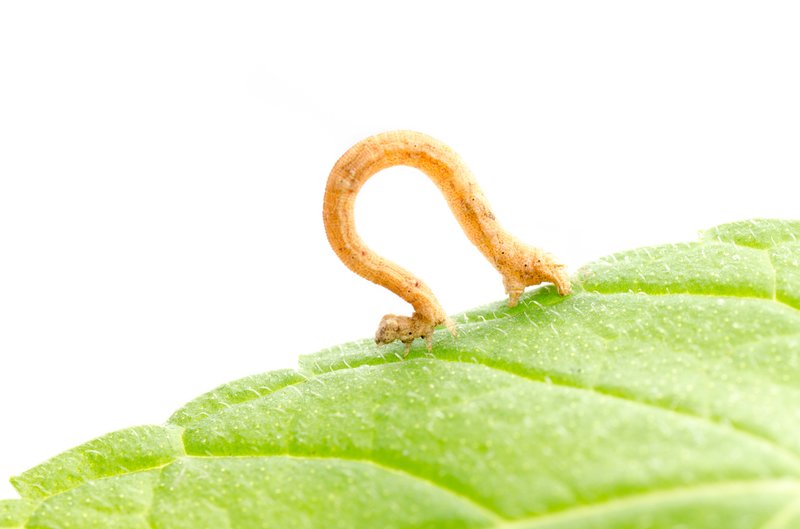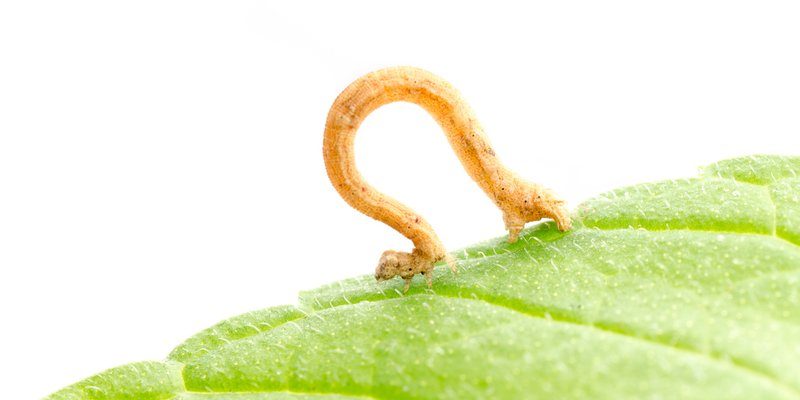
Both inchworms and loopers are not only cute but also play a crucial role in the ecosystem by serving as food for birds and other animals. They each have their own special way of moving that makes them quite interesting. So, as we explore their features, life cycles, and habitats, you’ll see just how unique each of these little guys truly is.
What Are Inchworms?
Inchworms are the larval stage of moths from the Geometridae family. You might first notice them by their unique way of moving — inching along in a way that looks almost like they’re measuring the ground with each movement. This style of locomotion explains their name! They have a few distinct characteristics that help you identify them easily.
Physical Features
Inchworms are typically green or brown, allowing them to blend in with their environment, such as leaves and stems. They have a soft body and usually measure about 1 to 2 inches long. Their most defining feature is the absence of the prolegs on the segment behind the head, resulting in a distinctive “looping” motion as they move. It’s like they’re doing tiny little yoga stretches while they inch their way along!
Behavior
Inchworms tend to be quite shy, often remaining still when they sense danger. They can curl up and drop from a leaf to escape predators. This tactic can be successful, as many animals overlook them at first glance. Plus, when they’re on a branch or leaf, their green or brown colors help them blend right in, making them masters of camouflage.
What Are Loopers?
Loopers are another type of caterpillar, also from the Geometridae family. While they might share some similarities with inchworms, there’s more to them than meets the eye! Loopers are known for their unique way of moving, which is somewhat similar to inchworms but with its own twist.
Physical Features
Loopers are often green, but can also be found in shades of brown or even pink. They usually grow to be about 1 to 3 inches long, and just like inchworms, they have a soft body. The most significant difference is that loopers tend to have more defined prolegs, which gives them a slightly different body shape and movement. They look almost like a tiny accordion as they loop.
Behavior
Loopers also employ a “freeze” tactic when threatened, but instead of dropping from a branch, they might hang still, trying to mimic twigs or leaves. This behavior, combined with their color, makes it a bit harder for predators to spot them. Imagine being so good at hide and seek that you can blend right in with your surroundings!
Comparing Movement: Inchworms vs. Loopers
One of the most noticeable differences between inchworms and loopers is how they move. It’s like watching two dancers perform different styles.
Inchworms
They “inch” forward by curling their bodies, creating a loop, then extending back out. This action resembles a measuring tape, giving them their name. If you take a moment to observe them, it’s somewhat mesmerizing how they stretch and retract.
Loopers
On the other hand, loopers tend to move in a more pronounced “looping” motion. Their movement is often described as more exaggerated, almost like a caterpillar doing a little dance. They will pull their back end up to their front end, which gives them that unique, “conga line” style of locomotion.
Life Cycle: Inchworms and Loopers
Both inchworms and loopers undergo complete metamorphosis, which means they go through four life stages: egg, larva (caterpillar), pupa, and adult moth. While their paths are similar, there are intriguing differences worth noting.
Inchworm Life Cycle
Inchworms typically start off as tiny eggs laid on leaves. Once they hatch, they quickly begin munching through foliage, growing rapidly. After several molts, they eventually form a cocoon and enter the pupal stage. From there, they emerge as adult moths, often with beautiful patterns on their wings.
Looper Life Cycle
Loopers follow a similar path. However, they tend to be more active feeders, often leading to quicker growth rates. They also create cocoons or pupate underground, depending on the species. The adult loopers often have striking wing colors and patterns that reflect their vibrant caterpillar stages.
Habitats: Where You’ll Find Them
When it comes to their preferred habitats, both inchworms and loopers can be found in similar environments, but there are some nuances that set them apart.
Inchworm Habitats
Inchworms are commonly found on trees and shrubs, as they feed primarily on leaves. They love lush, green environments, making gardens and forests prime real estate for them. Their ability to camouflage themselves helps them avoid predators in these areas.
Looper Habitats
Loopers can also be found in forests and gardens, but they’re often more prone to roaming. Because of their active feeding habits, they might venture onto a wider variety of plants. You’ll often spot them on wildflowers and herbs, where their “snacking” can be observed while they loop around.
Why Should We Care About Inchworms and Loopers?
You might be wondering why these little caterpillars matter. Well, they play a vital role in the ecosystem. Both inchworms and loopers contribute to the food chain by acting as prey for birds, spiders, and other insects.
Impact on Plants
While they munch on leaves, they can also affect plant health. In small numbers, they provide a food source for other animals without causing too much harm. But if their populations explode, they can defoliate plants, which can lead to various issues in gardens and crops. Balancing populations is crucial for healthy ecosystems.
Educational Opportunities
Lastly, studying these caterpillars can offer valuable insights into the life cycles of insects. They make great subjects for nature education, allowing both kids and adults to learn about metamorphosis and the importance of biodiversity.
Understanding the differences between inchworms and loopers gives us a glimpse into the fascinating world of caterpillars. While they might seem similar at first glance, their distinct movements, life cycles, and habitats showcase the diverse strategies these little creatures have developed for survival. Next time you’re out in nature and spotting tiny caterpillars, you can share your newfound knowledge about these amazing insects!
So, whether you’re looking for a fun fact to share at a garden party or just curious about the critters in your backyard, you now know what sets inchworms and loopers apart. Keep exploring the natural world, and who knows what other intriguing differences you’ll uncover!

